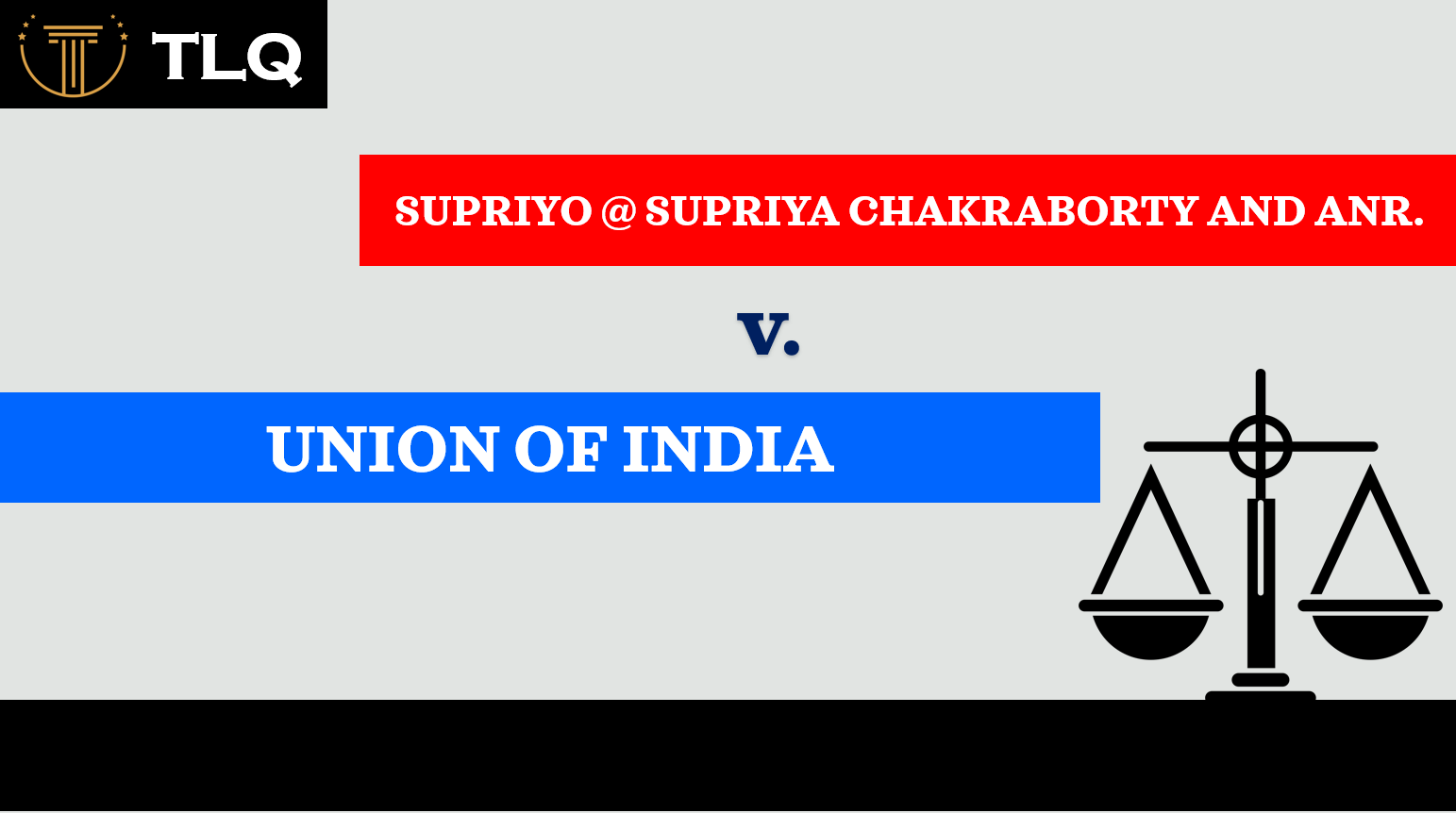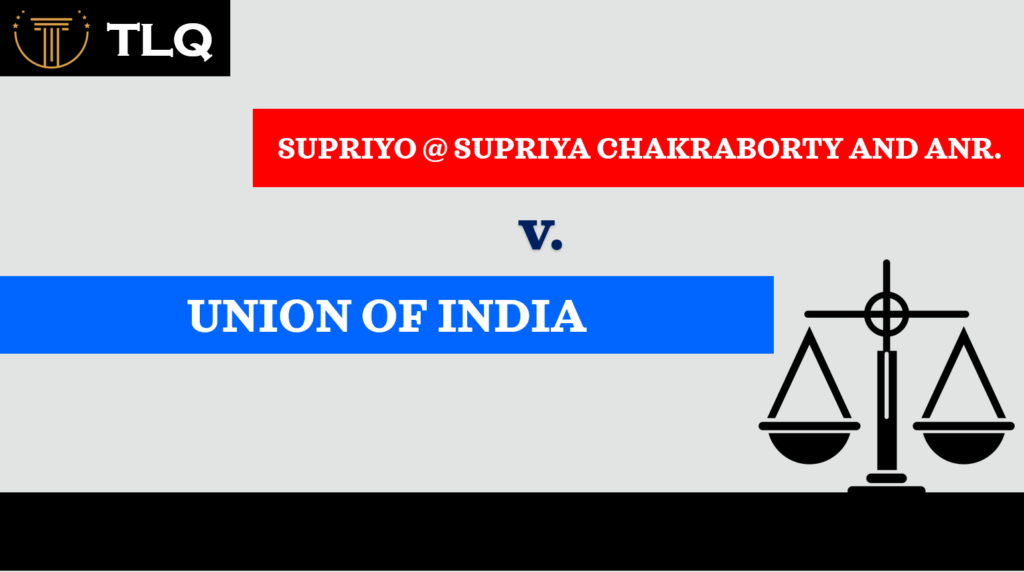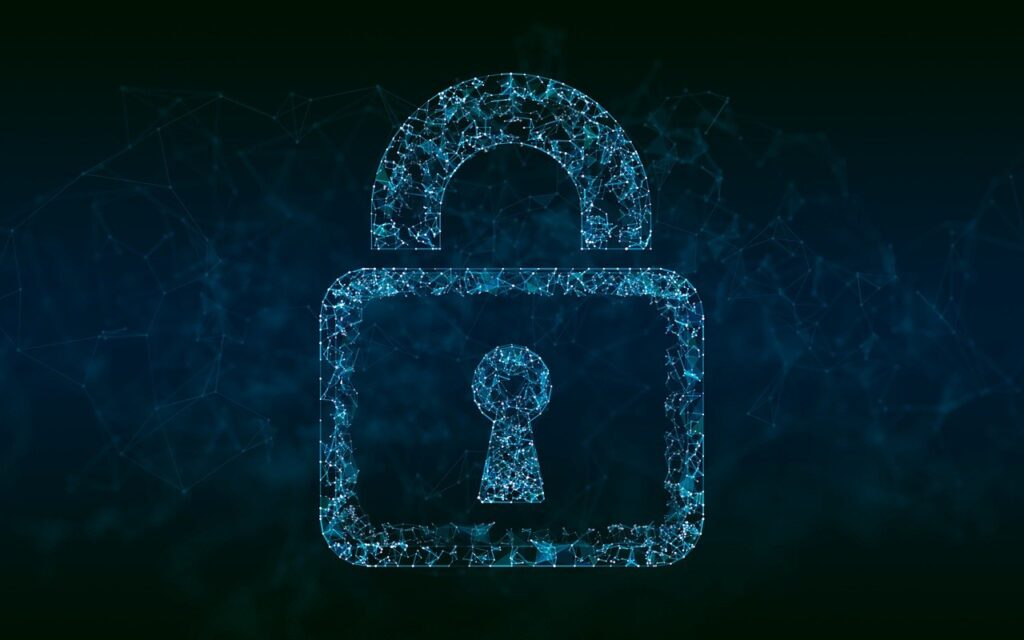Published On: 22nd June, 2024

Authored By: Shreya Sharma
CASE: SUPRIYO @ SUPRIYA CHAKRABORTY AND ANR. VS UNION OF INDIA
[ A NO TO SAME-SEX MARRIAGE]
- CITATION: Writ Petition (Civil) No. 1011 of 2022
- DATE OF JUDGEMENT: 17th October,2023
- COURT: Supreme Court of India
- PETITIONER: Supriyo @ Supriya Chakraborty & Anr.
- RESPONDENT: Union Of India
- BENCH: CJI D.Y. Chandrachud, J. S.K. Kaul, J. Ravindra Bhat, J. Hima Kohli & J. S. Narasimha.
- LEGAL PROVISIONS: Articles 14, 15, 19, 21, and 25 of the Indian Constitution, the Special Marriage Act of 1954, Hindu Marriage Act of 1955, Foreign Marriage Act of 1969.
INTRODUCTION
The Supreme Court of India heard a number of historic cases, including this one, to decide whether or not to provide members of sexual and gender minority groups in India the ability to get married and start a family. 52 petitioners filed 20 related cases before a five-judge Constitution Bench that included Chief Justice of India D.Y. Chandrachud, Justices S.K. Kaul, S.R. Bhat, Hima Kohli, and P.S. Narasimha. In light of protections from discrimination, the right to equality, dignity, personal liberty, privacy, and autonomy, as well as freedom of conscience and expression, the petitioners—couples and individuals from communities of sexual and gender minorities—demand recognition of the right to marry and start a family. Because of the Court’s institutional constraints, the decision instructs the Union government to form a committee to determine the extent of rights for queer couples in unions, but it does not explicitly recognize same-sex marriage under current statutes. While Justices Kaul and Narasimha had differing perspectives on several points, Justice Bhat’s dissenting decision entirely denied the notion of an affirmative constitutional right in this area. The ruling presents a number of issues about the judiciary’s function in social change, how it interacts with the legislative on policy issues, and how it interprets the Constitution. A turning point in Indian law was reached in the case of Supriya Chakraborty and Others v. Union of India. Beyond its direct consequences for personal autonomy and reproductive rights.
BACKGROUND OF THE CASE
- The decision of the court in Navtej Singh Johar:
Criminalizing “carnal intercourse against the order of nature” in Section 377 of the Indian Penal Code 1860. Numerous examples of the State abusing the provision to violate the autonomy and dignity of those who had intercourse with someone of the same sex may be found throughout history. After independence, a colonial provision that upheld Victorian morals persisted in the statute. Additionally, people who identify as gender non-conforming were targeted by Section 377. Judicial scrutiny and public mockery were applied to intimate relationships and activities. The State robbed homosexuals and gender-nonconforming people of their identity and personality by making their sexual behaviour illegal. People who disobeyed the law and avoided punishment suffered from social exclusion.
- Naz Foundation v. Government of NCTD:
In order to prohibit consensual homosexual sexual behaviour between adults, a Division Bench of the High Court of Delhi interpreted Section 377 of the IPC. In an appeal, this court’s two-judge bench. The verdict of the Delhi High Court was overturned by the court in Suresh Kumar Kaushal v. Naz Foundation5. A three-judge bench of this court was assigned to hear a writ petition that aimed to declare Section 377 of the IPC unconstitutional and to recognize the rights to sexuality, sexual autonomy, and choice of a sexual partner as rights guaranteed by Article 21 of the Constitution. In light of the rulings of this court, the petitioners contended that the case needed to be referred to a five-judge bench.
- Union of India and Justice KS Puttaswamy (9J) v. Union of India:
According to NALSA (supra), this Court ruled that people who don’t fit into the male-female binary should be recognized by the state as “third gender persons,” and they should be granted all rights protected by the constitution. It further mandated that transgender people’s self-identified gender, including when they identify as male or female, be legally recognized by the Union and State Governments. This Court ruled in Justice KS Puttaswamy (9J) (above) that an individual’s right to express their sexual orientation is protected by the Constitution.
FACTS OF THE CASE
Two same-sex couples, Supriyo Chakraborty and Abhay Dang, along with Parth Phiroze Mehrotra and Uday Raj Anand, filed writ petitions before the Supreme Court on November 14, 2022, marking a significant legal milestone in India. The focus of their petitions is on Section 4(c) of the Special Marriage Act, 1954 (the Act), which presently limits marriage to a “male” and a “female.” The petitions centre on the Act’s validity. These courageous petitioners contend that the prohibition unfairly discriminates against same-sex couples by denying them access to opportunities such as surrogacy, adoption, work, and retirement benefits, among other crucial marriage benefits. They have asked the Court to rule that Section 4(c) of the Act is unconstitutional. This argument has been linked to a number of previous petitions that have been filed against various personal laws on comparable grounds, such as the Foreign Marriage Act of 1969 and the Hindu Marriage Act of 1955.
Their position is based on the conviction that basic rights including equality, freedom of speech, and human dignity are violated by the refusal to acknowledge same-sex marriage. They have used two significant rulings, NALSA v. Union of India (2014) and Navtej Singh Johar v. Union of India (2018), to bolster their argument. The Supreme Court presided over by Chief Justice D.Y. Chandrachud and Justice Hima Kohli, made history on November 25, 2022, when it issued an order. This Order paved the way for a legal discussion on same-sex marriage recognition in India by directing the Union to reply to the petitions. It’s important to note that comparable petitions are pending before the High Courts in Kerala and Delhi, indicating a growing movement in India to acknowledge the equality and rights of the LGBTQ+ population.
ISSUE RAISED
- Does the Supreme Court have the authority to consider this case?
- Do people who identify as LGBTQIA+ have the right to marry?
- Can the SC issue a declaration stating that LGBTQIA+ people have the right to marry?
- Does the Special Marriage Act of 1954’s exclusion of LGBTQIA+ weddings constitute discrimination in accordance with Article 14?
- Can gay couples who are not married adopt?
- Is it legal for transgender people in heterosexual relationships to be married?
- Is the Special Marriage Act, of 1954 unconstitutional?
CONTENTIONS OF APPEALING
The petitioners argued that segregation and prohibition, as consolidated in section 4(c) and various SMA arrangements, are ultra-vires in the Constitution and that the basic freedom to marry the person of one’s choosing is guaranteed by Articles 14, 15, 19, 21, and 25. Articles 14, 15, 19, 21, and 25 are violated if their right to marriage is denied. Article 21 covers the right to happiness, which includes having a fulfilling relationship with a person of one’s own choosing. Everyone has the right to get married to the person of their choosing. The exercise of this right is equally entitled to queer persons. The SMA should be interpreted without regard to gender. Terms denoting gender, such as “wife” and “husband,” should be interpreted as “spouse.” The legal definitions of “family” and “household” are wide and do not only apply to a “biological” couple, their offspring, and themselves. Only married couples are eligible for surrogacy and adoption, depriving LGBTQ couples of the opportunity to start a family and denying LGBTQIA+ people equal legal protection. LGBTQIA+ people face discrimination when their marriage is not recognized, and they are also denied privileges under social welfare and advantageous laws.
CONTENTIONS OF REPONDENT
Matrimony, as defined by our social, cultural, and legal systems, is by its very nature a partnership between people of different genders. The judiciary should not be allowed to interpret this idea, and competent legislators should make any changes. Based on individual laws, marriages take many forms. It is a revered ritual among Hindus that emphasizes the reciprocal responsibilities of a man and a woman. In Islam, there is a contract, but it only applies to men and women who are biological. To urge the court to alter this long-standing, deeply rooted legislative policy in both society and religion would be inappropriate. The Petitioners are unable to claim that the Indian Penal Code’s legalization of Section 377 violates their basic right to have same-sex marriages recognized by the legal system. The Hon’ble Supreme Court made it apparent in the case of Navtej Singh Johar v. Union of India (2018) 10 SCC 1 that while individuals enjoy the right to union under Article 21 of the Constitution, this does not imply marriage. According to codified legislation like the Hindu Marriage Act of 1955 and the Christian Marriage Act of 1872, marriage in India is defined as the union of a biological man and a biological woman. This institution has significant social and legal repercussions beyond just being acknowledged.
Family matters, including rights. Marriage in India is defined by law as the uniting of a biological male and a biological woman. This idea is made evident by the many laws, including criminal laws, personal laws, and legislation that use specific terminology like “husband” and “wife,” “male” and “female,” “bride” and “bridegroom,” among others. The Court is powerless to change India’s stated legislative policy, which is represented by this.
RATIONALE
The Hon’ble Supreme Court did not consider the question of whether the Constitution recognizes the freedom to marry in the cases of Justice KS Puttaswamy, Shafin Jahan, and Shakti Vahini. The rulings in Navtej (above) and Justice KS Puttaswamy (9J) (above) acknowledge LGBT couples’ freedom to choose whether or not to form a relationship. There is a defence against outside threats in this connection. Article 15 prohibits discrimination based on sexual orientation. In accordance with the ruling in Common Cause v. Union of India, as amended by Common Cause v. Union of India, medical professionals are required to confer with patients’ families, closest friends, or next of kin in the case that a terminally ill patient has not executed an Advance Directive. In a union, parties can include. In order to avoid creating judicial legislation, this Court is unable to insert language into the SMA’s provisions or the provisions of other related statutes like the ISA and the HSA.
DEFECTS OF LAW
Rejecting same-sex marriage’s legal recognition is a regretful decision made by the majority, to be sure. There are multiple problems with the majority’s argument. First, the majority’s claim that the right to marry is not a fundamental right is refuted by the Indian Constitution. Second, the majority’s claim that same-sex couples have more legal options is misleading. Under live-in and civil partnership agreements, same-sex couples are not entitled to the same legal rights and protections as they are under marriage. However, the dissenting opinion written by Justices Chandrachud and Kohli presents a compelling case for same-sex marriage that is well-reasoned. It is accurate for the opposing judges to acknowledge that same-sex couples have the same legal right to marry as heterosexual couples and that this right is basic.
The Supreme Court’s ruling in Supriyo v. Union of India is an uneventful decision overall. Although the LGBTQ+ community in India is disappointed, there is still optimism that the Supreme Court will eventually allow same-sex marriage in the country thanks to the dissenting opinion.
INFERENCE
For the LGBTQ+ community in India, the Supreme Court’s decision in Supriyo v. Union of India surely represents a major blow. LGBTQ+ rights activists were disappointed and enraged by the ruling, which denied same-sex marriage legal recognition and gave the Parliament jurisdiction over the issue. Nevertheless, in the face of this disappointment, the dissenting opinion expressed by Justices Chandrachud and Kohli offers some optimism. A ray of hope comes from their dissenting position, in which they vehemently maintained that same-sex couples’ rights are violated by Section 4(c) of the Special Marriage Act and that the right to marry is, in fact, a basic right. Their viewpoint raises the prospect that the Supreme Court may change its mind in the future and move closer to allowing same-sex unions in India.
While the majority opinion produced a depressing result, Justices Chandrachud and Kohli’s dissenting opinions serve as a reminder that the fight for equality and LGBTQ+ rights in India is still ongoing.



